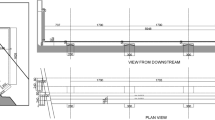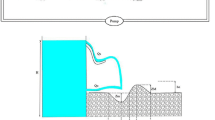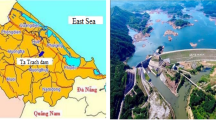Abstract
With the rapid development of high dam projects within China, the dragon-drop-tail spillway tunnel is introduced and widely used. In view of the high water head and the large flow velocity on the dragon-drop-tail section, aerator devices are usually placed for the cavitation damage control. For the device placed in its initial position, it is a serious concern to design a suitable flow regime of the cavity and to control the cavity filling water due to the large flow depth and the low Froude number through this aerator. In this study, the relationships between the geometries of the aerator device and the jet impact angle of the lower trajectory of the flow are theoretically analyzed with/without a local slope. Nine test cases with different geometries are designed, the effectiveness of the filling water control is experimentally investigated under different operation conditions, and two criteria of the local slope design are proposed. It is concluded that the cavity flow regime and the filling water can be improved if a small impact angle and some suitable geometries of the local slope are designed.
Similar content being viewed by others
References
GUO Jun. ZHANG Dong and LIU Zhi-** et al. Achievements on hydraulic problems in large spillway tunnel with a high head and large discharge flow and its risk analysis[J]. Journal of Hydraulic Engineering, 2006, 37(10): 1193–1198(in Chinese).
CHANSON H. Study of air entrainment and aeration devices[J]. Journal of Hydraulic Research, 1989, 27(3): 301–319.
HAGER W. H., PFISTER M. Historical advance of chute aerators[C]. 33rd IAHR Congress. Vancouver, Canada, 2009, 5827–5834.
PFISTER M. Chute aerators: Steep deflectors and cavity subpressure[J]. Journal of Hydraulic Engineering, ASCE, 2011, 137(10): 1208–1215.
ZHI Shuan-xi, YAN **-yuan. Hydraulic characteristics of aerators with dent-form ramp[J]. Journal of Hydraulic Engineering, 1991, (2): 42–46(in Chinese).
SUN Shuang-ke, YANG Jia-wei and LIU Haitao. Optimistic study on the layout of aeration facilities under mild gradient[J]. Water Resources and Hydropower Engineering, 2004, 35(11): 26–29(in Chinese).
WANG Hai-yun, DAI Guang-qing and YANG Qing et al. Experimental study on V-type aerator for spillway tunnel with inlet raised[J]. Journal of Hydraulic Engineering, 2005, 36(11): 1371–1378(in Chinese).
WU Jian-hua, MA Fei and DAI Hui-chao. Influence of filling water on air concentration[J]. Journal of Hydrodynamics, 2011, 23(5): 601–606.
SU Pei-lan, LIAO Hua-sheng and QIU Yue et al. Experimental study on a new type of aerator in spillway with low Froude number and mild slope flow[J]. Journal of Hydrodynamics, 2009, 21(3): 415–422.
WU Jian-hua, MA Fei. Cavity flow regime for spillway aerators[J]. Science China Technological Sciences, 2013, 56(4): 818–823.
PFISTER M., HAGER W. H. Chute aerators. I: Air transport characteristics[J]. Journal of Hydraulic Engineering, ASCE, 2010, 136(6): 352–359.
PFISTER M., HAGER W. H. Numerical computation of slit-type supercritical flows[J]. Journal of Hydraulic Engineering, ASCE, 2010, 136(6): 360–367.
PFISTER M. Jet impact angle on chute downstream of aerator[C]. 4rd IAHR International Symposium on Hydraulic Structures. Porto, Portugal, 2012, 1–8.
QI Li-jian, LIAO Hua-sheng and LI Gui-ji et al. Numerical simulation of backwater downstream of aerators in spillway with low Froude number flow[J]. Journal of Hydraulic Engineering, 2007, 38(7): 819–825(in Chinese).
SU Pei-lan, LIAO Hua-sheng and LI Lian-xia et al. Application of aerator with a trapezoidal-shaped slot on a steep slope to the spillway tunnel of Pubugou hydropower project[J]. Journal of Hydroelectric Engineering, 2010, 29(2): 168–175(in Chinese).
Author information
Authors and Affiliations
Corresponding author
Additional information
Project supported by the National Natural Science Foundation of China (Grant No. 51179114).
Biography: QIAN Shang-tuo (1988-), Male, Ph. D. Candidate
Rights and permissions
About this article
Cite this article
Qian, St., Wu, Jh., Ma, F. et al. Cavity filling water control below aerator devices. J Hydrodyn 26, 424–430 (2014). https://doi.org/10.1016/S1001-6058(14)60048-2
Received:
Revised:
Published:
Issue Date:
DOI: https://doi.org/10.1016/S1001-6058(14)60048-2




